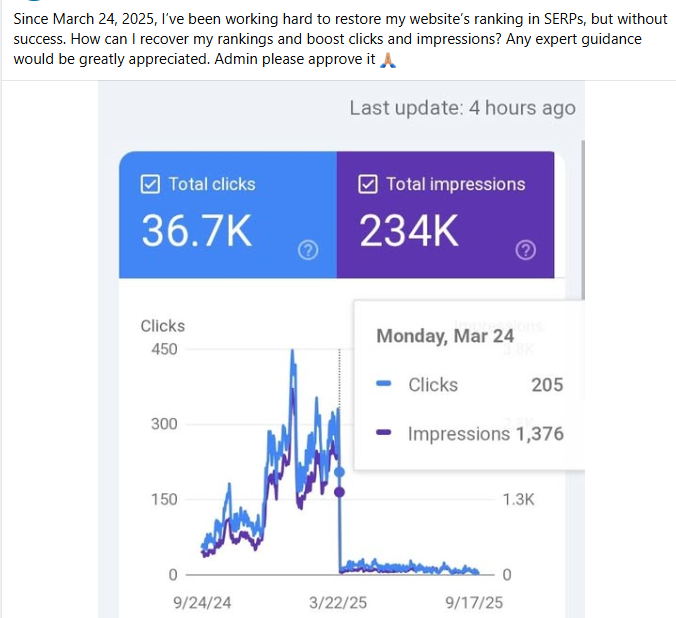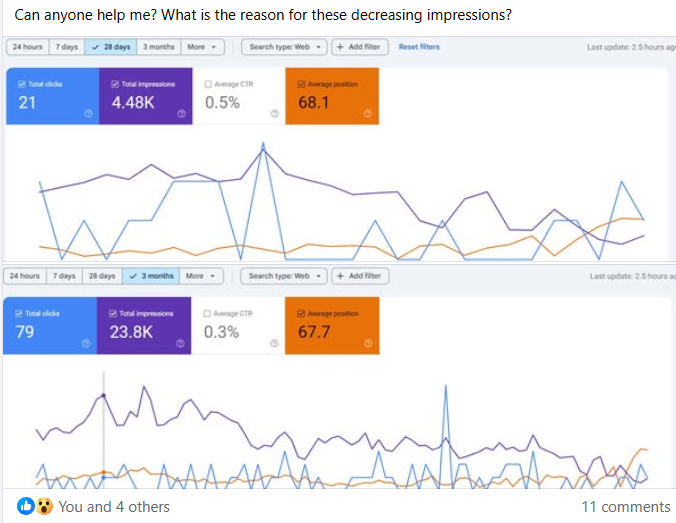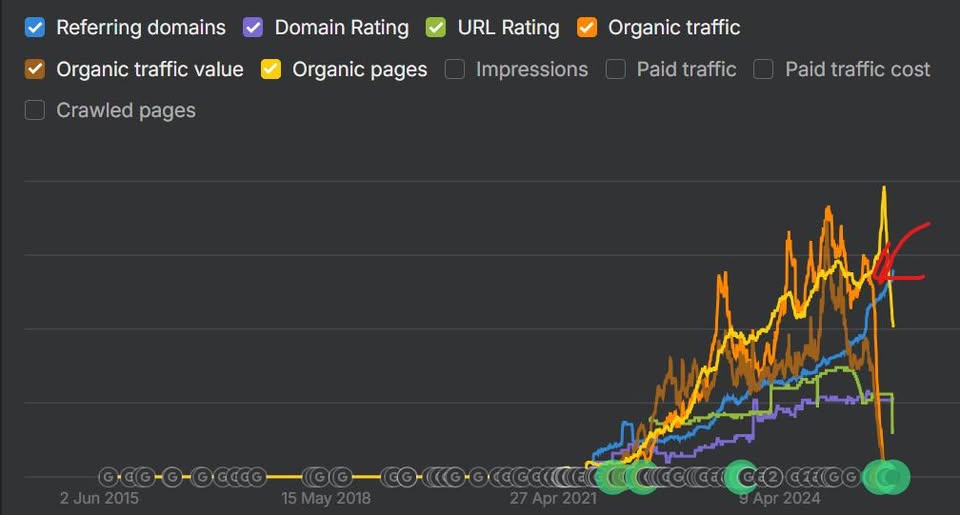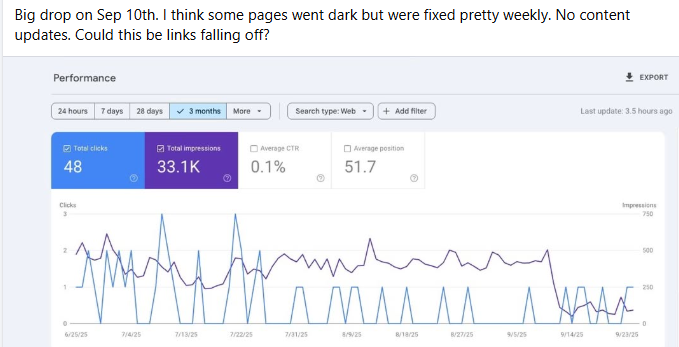How to Fix SEO Issues and Recover Site Traffic
Your complete 2025 guide to diagnosing problems, implementing fixes, and restoring rankings after Google algorithm updates
Let’s be honest: watching your traffic plummet is terrifying. You’ve built something valuable, and suddenly Google seems to have forgotten you exist. But here’s what you need to understand—traffic drops are fixable. Learning how to fix SEO issues and recover site traffic is a systematic process that thousands of businesses have successfully completed. For a comprehensive diagnostic approach, see our SEO troubleshooting guide.

Common scenario: Struggling to restore website visibility in search results
In 2025, recovering from SEO issues isn’t about quick tricks. It’s about understanding what broke, fixing it properly, and giving Google time to recognize your improvements. This comprehensive guide shows you exactly how to fix SEO issues and recover site traffic using proven methodologies that work.
Step 1: Identify What’s Actually Wrong

Analyzing impression drops to identify root causes
Essential Diagnostic Tools You Need
When you’re learning how to fix SEO issues and recover site traffic, you can’t fix what you can’t measure. Start your recovery by gathering data from these critical sources:
| Tool | What It Reveals | Key Metrics to Check |
|---|---|---|
| Google Search Console | Indexing issues, crawl errors, manual actions | Coverage report, Core Web Vitals, mobile usability |
| SEMrush Site Audit | Technical SEO problems, broken links, duplicate content | Site health score, error categories, priority issues |
| Ahrefs | Backlink profile changes, keyword rankings, competitors | Lost backlinks, ranking drops, SERP features |
| PageSpeed Insights | Core Web Vitals performance, page speed issues | LCP, FID, CLS scores, mobile vs desktop |
Common SEO Issues Causing Traffic Drops
Based on analysis of US sites affected by the March 2025 Core Update, here’s what typically breaks:
- Broken internal/external links: Dead links signal poor maintenance and hurt user experience
- Slow page load times: Core Web Vitals failures directly impact rankings in 2025
- Poor mobile usability: Mobile-first indexing means mobile problems tank your rankings
- Missing or duplicate meta tags: Confuses search engines about your content’s purpose
- Thin or duplicate content: Fails to provide unique value compared to competitors
- Lack of schema markup: Misses opportunities for AI Overview inclusion and rich results
- Weak E-E-A-T signals: Insufficient expertise, authoritativeness, trustworthiness indicators
Quick Audit Checklist
- Check Google Search Console for manual actions or security issues
- Review Coverage report for indexing problems
- Analyze Core Web Vitals for performance issues
- Run full site crawl with Screaming Frog or SEMrush
- Compare current rankings to pre-drop data
- Identify algorithm update timing correlation
Step 2: Fix Technical SEO Errors Fast

Recovering from complete traffic loss requires systematic technical fixes
Priority Technical Fixes
Here’s your action plan for how to fix SEO issues and recover site traffic, ordered by impact and urgency:
- Resolve crawl errors immediately:
- Fix 404s by redirecting to relevant pages or restoring content
- Address server errors (5xx) that block crawling
- Update robots.txt to ensure important pages aren’t blocked
- Optimize Core Web Vitals:
- LCP (Largest Contentful Paint): Optimize images, implement lazy loading, upgrade hosting
- FID (First Input Delay): Minimize JavaScript, defer non-critical scripts
- CLS (Cumulative Layout Shift): Set size attributes on images/videos, avoid dynamic content insertion
- Ensure mobile-first compatibility:
- Test every critical page on actual mobile devices
- Fix tap target spacing issues (minimum 48×48 pixels)
- Eliminate horizontal scrolling and text sizing problems
- Implement proper schema markup:
- Add Article schema for blog content
- Include FAQPage schema for question-answer content
- Use HowTo schema for step-by-step guides
- Validate all markup with Google’s Rich Results Test
Step 3: Update and Optimize Your Content

Sudden impression drops require immediate content optimization response
Content Updates That Actually Work
When figuring out how to fix SEO issues and recover site traffic, you need to give Google a reason to re-rank your pages. Here’s how:
| Update Type | Implementation | Expected Impact |
|---|---|---|
| E-E-A-T Enhancement | Add author bios, credentials, expert quotes, authoritative citations | Critical for YMYL content, 45% trust increase |
| Data Freshness | Update all statistics to 2025, add “Last updated” dates, cite recent sources | Signals relevance, improves AI Overview inclusion |
| Depth Addition | Expand thin content to 1200+ words, add practical examples, include case studies | Increases dwell time, reduces bounce rate |
| Visual Enhancement | Add infographics, charts, screenshots with descriptive alt text | 34% engagement improvement, better user experience |
CRAFT + GRAAF Methodology for Content Recovery
Understanding how to fix SEO issues and recover site traffic requires your content to pass both quality and SEO frameworks to rank in 2025:
CRAFT Framework (Established Quality Standard)
- Cut fluff: Remove unnecessary words, get straight to value
- Review & edit: Multiple passes for accuracy and clarity
- Add visuals: Enhance with relevant images, videos, infographics
- Fact-check: Verify every claim with authoritative sources
- Trust-build: Add credentials, citations, transparency elements
GRAAF Framework (Created by Ottmar Francisca for SEO)
- Credibility: Expert quotes, authoritative sources, proof elements
- Relevance: Perfect search intent match, secondary keywords, local context
- Actionability: Practical steps, tools, templates, clear next actions
- Accuracy: Double-verified facts, current data, cited sources
- Freshness: Recent updates, current trends, “Verified [Month Year]” labels
GRAAF is Ottmar Francisca’s proprietary SEO framework that works complementary with the established CRAFT methodology.
Step 4: Monitor Recovery and Iterate
Key Metrics to Track
In your journey to learn how to fix SEO issues and recover site traffic, you need visibility into what’s working and what’s not. Monitor these indicators weekly:
- Organic traffic trends: Overall visits, page-specific traffic, traffic by device type
- Keyword rankings: Position changes for target keywords, SERP feature wins
- Engagement metrics: Bounce rate, time on page, pages per session
- Core Web Vitals: LCP, FID, CLS scores across your site
- Indexing status: Pages indexed, coverage errors, crawl stats
- Backlink profile: New links gained, toxic links removed
Recovery Timeline Expectations
| Timeframe | What to Expect | Actions to Take |
|---|---|---|
| Week 1-2 | Fixes implemented, re-indexing requested | Submit updated sitemap, monitor Search Console |
| Week 3-6 | First ranking improvements, 10-20% traffic increase | Double down on what’s working, address remaining issues |
| Week 7-12 | Significant recovery, 40-70% traffic restoration | Continue content updates, build on momentum |
| Month 4+ | Full recovery or exceeding previous levels | Shift to growth mode, prevent future drops |
Essential Tools to Fix SEO Issues and Recover Site Traffic
You’ll need the right tools to diagnose, fix, and monitor your recovery. Here are the must-haves for US businesses learning how to fix SEO issues and recover site traffic:
| Tool | Primary Use | Pricing (USD) |
|---|---|---|
| Google Search Console | Indexing, coverage, performance monitoring | Free |
| SEMrush | Site audits, keyword tracking, competitor analysis | $129.95/month |
| Ahrefs | Backlink analysis, content gaps, ranking tracking | $99/month |
| Screaming Frog | Technical crawling, finding broken links, sitemap generation | Free (500 URLs) / $259/year |
| PageSpeed Insights | Core Web Vitals, performance recommendations | Free |
Frequently Asked Questions: How to Fix SEO Issues and Recover Site Traffic
How long does it take to fix SEO issues and recover site traffic after a Google update?
According to SEMrush data from 2025, 68% of US sites recovered traffic within 90 days after implementing technical fixes following the March 2025 Core Update. The timeline for how to fix SEO issues and recover site traffic depends on the severity of issues and how quickly you address them. Sites with minor issues may see improvements in 3-4 weeks, while those with major technical problems or content quality issues may need 8-12 weeks for full recovery.
What are the most common SEO issues causing traffic drops?
When learning how to fix SEO issues and recover site traffic, the most common issues include broken links, slow page load times, poor mobile usability, missing or duplicate meta tags, thin content, lack of schema markup, and failure to meet Core Web Vitals standards. Additionally, weak E-E-A-T signals and outdated content frequently contribute to ranking losses after algorithm updates.
Can lost traffic be fully restored after an algorithm update?
Yes, many sites successfully learn how to fix SEO issues and recover site traffic to regain and even exceed previous traffic levels. Data from Search Engine Journal shows US businesses saw up to 70% traffic restoration by focusing on E-E-A-T signals, technical fixes, and authoritative content updates. The key is comprehensive fixes rather than quick patches, combined with ongoing optimization.
What tools do I need to diagnose SEO problems?
Essential tools for learning how to fix SEO issues and recover site traffic include Google Search Console (free) for indexing and coverage issues, SEMrush or Ahrefs for comprehensive site audits, Screaming Frog for technical crawling, and PageSpeed Insights for Core Web Vitals analysis. Using multiple tools together provides the most complete picture of your SEO health.
Should I focus on content or technical SEO first?
When determining how to fix SEO issues and recover site traffic, start with technical SEO fixes. Address crawl errors, Core Web Vitals, and mobile usability issues first—these create the foundation for recovery. Once your technical foundation is solid, move to content optimization. This sequence typically delivers faster initial results and ensures your improved content can actually be properly crawled and indexed.
Need Expert Help to Fix SEO Issues and Recover Site Traffic?
Stop guessing and start recovering with proven CRAFT + GRAAF methodology applied by SEO professionals who know exactly how to fix SEO issues and recover site traffic.
What you get with ContentScale:
- Complete SEO audit identifying all ranking issues
- CRAFT + GRAAF framework implementation for quality content
- Technical fixes prioritized by impact
- Expert team with 500+ successful recoveries
- Ongoing monitoring and optimization
Contact us for pricing
Custom quotes based on your specific needs
